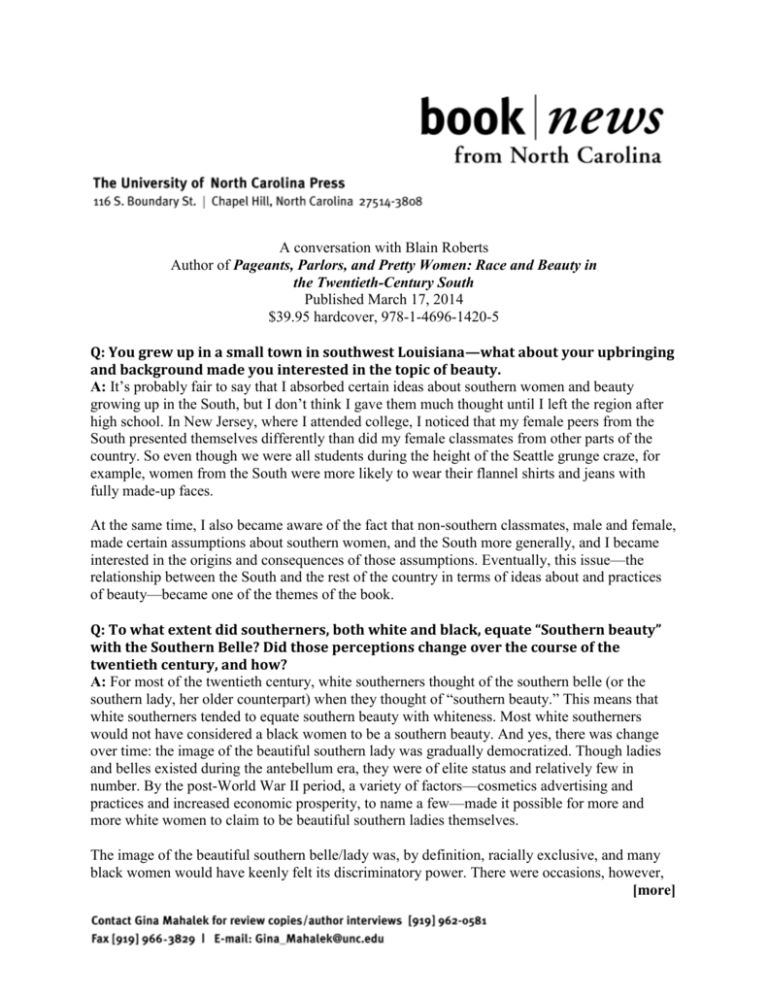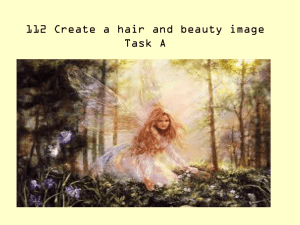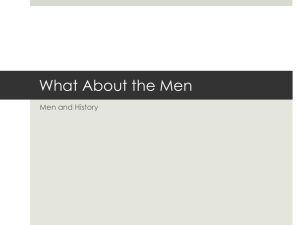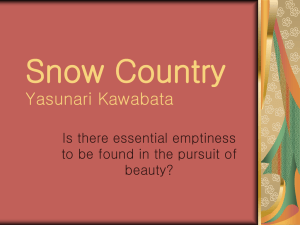Roberts Q&A
advertisement

A conversation with Blain Roberts Author of Pageants, Parlors, and Pretty Women: Race and Beauty in the Twentieth-Century South Published March 17, 2014 $39.95 hardcover, 978-1-4696-1420-5 Q: You grew up in a small town in southwest Louisiana—what about your upbringing and background made you interested in the topic of beauty. A: It’s probably fair to say that I absorbed certain ideas about southern women and beauty growing up in the South, but I don’t think I gave them much thought until I left the region after high school. In New Jersey, where I attended college, I noticed that my female peers from the South presented themselves differently than did my female classmates from other parts of the country. So even though we were all students during the height of the Seattle grunge craze, for example, women from the South were more likely to wear their flannel shirts and jeans with fully made-up faces. At the same time, I also became aware of the fact that non-southern classmates, male and female, made certain assumptions about southern women, and the South more generally, and I became interested in the origins and consequences of those assumptions. Eventually, this issue—the relationship between the South and the rest of the country in terms of ideas about and practices of beauty—became one of the themes of the book. Q: To what extent did southerners, both white and black, equate “Southern beauty” with the Southern Belle? Did those perceptions change over the course of the twentieth century, and how? A: For most of the twentieth century, white southerners thought of the southern belle (or the southern lady, her older counterpart) when they thought of “southern beauty.” This means that white southerners tended to equate southern beauty with whiteness. Most white southerners would not have considered a black women to be a southern beauty. And yes, there was change over time: the image of the beautiful southern lady was gradually democratized. Though ladies and belles existed during the antebellum era, they were of elite status and relatively few in number. By the post-World War II period, a variety of factors—cosmetics advertising and practices and increased economic prosperity, to name a few—made it possible for more and more white women to claim to be beautiful southern ladies themselves. The image of the beautiful southern belle/lady was, by definition, racially exclusive, and many black women would have keenly felt its discriminatory power. There were occasions, however, [more] 2-2-2 Pageants, Parlors, and Pretty Women when individuals and institutions attempted to claim the image for black women, to challenge its underlying racial assumptions and reframe its meaning. An interesting example is a photo spread that ran in Ebony magazine in 1971 entitled “Belles of the South” that featured young women from southern historically black colleges. The magazine said very explicitly that it wanted to prove that not all southern beauties were white—that black women were belles of the South, too. Q: The power of advertising plays a large role in the public perception of beauty. Can you describe some of the potent examples of how beauty products and their advertising favored and encouraged racial standards of beauty? A: The use of the southern lady in advertising is actually a great example of this phenomenon. One manufacturer of cosmetics in the early twentieth century, the National Toilet Company of Paris, Tennessee, based one of its major marketing campaigns on the southern lady, including images of southern ladies in ads and praising their beauty as every white southern woman’s birthright. This was all the more significant because some of the company’s best-selling products were lightening powders and bleaching creams—products, in other words, designed to make white women’s skin whiter. Advertising aimed at black southern women promoted racial standards of beauty in ways that might seem shocking to people today. At the turn of the century, one Richmond, Virginia, company marketed a hair straightener and a bleaching cream called “black skin remover” by showing before-and-after images in its ads. The before picture was a woman who was clearly black; the after picture was of a woman who was clearly white. That said, some early black female entrepreneurs like Madam C.J. Walker fought hard to undermine these kinds of images in their own ad campaigns. Walker, for example, argued that her hair products grew, not straightened, hair. She emphasized the importance of healthy hair to personal respectability and race pride. Q: Readers might be surprised by how beauty was used to resist and achieve desegregation in the Civil Rights Movement. How did that differ from the use of beauty in the Jim Crow Era? A: Any difference that did exist was a difference in degree, not in kind. In other words, the pursuit of beauty among white southern women had often served to sustain Jim Crow, while the pursuit of beauty among black southern women had often served to destroy it. For example, during Jim Crow, better baby contests and 4-H club health pageants, which judged the bodies of white babies and adolescents, respectively, drew on eugenics and rewarded “superior” racial specimens. Winners of the competitions testified to the strength and superiority of the white race. It wasn’t much of a stretch for the winners and contestants of the Miss America Pageant system in the 1950s and 1960s to make the same statements with their bodies as segregation came under fire. Black beauticians, meanwhile, worked for the welfare of their communities throughout the Jim Crow era. One Atlanta beautician founded three different civic organizations during the interwar decades to tackle racial inequality in her city. Once the black freedom struggle assumed the proportion of a [more] 3-3-3 Pageants, Parlors and Pretty Women mass movement, black beauticians like her simply harnessed their well-honed organizational skills for this new stage in the struggle. Q: You discuss how black beauty parlors became cultural centers within the black community. What types of movements were born in these types of gathering places? How was beauty used as an expression of empowerment? A: Again, beauty parlors were central to the fight against segregation even before the 1950s and 1960s. As I was doing my research, I was struck by the fact that almost every time I skimmed a black newspaper, I ran across a story about a beautician or beauticians’ organization and the work they were doing to combat racial injustice in their communities. Beauticians were uniquely positioned to engage in activities, like voter registration drives or NAACP membership recruitment campaigns. That’s because beauticians were independent businesswomen who did not answer to white employers, as, say, domestics or public school teachers did. And of course the shops themselves proved crucial to this work, too, since one of the main things that goes on in beauty parlors is talking. One Charleston, South Carolina, beautician became so involved in taking customers to register to vote that she would leave wethaired women behind, sitting under hair driers. Over time, customers would phone the shop to see if she would even be doing hair. But I also think it’s important to recognize how beauty empowered black women in more subtle ways as well. Beauty shops represented spaces of refuge for tired black women who worked all day in the fields, in factories, or in white homes. Black beauticians took pains to make their shops relaxing and to make the grooming process itself enjoyable. In beauty parlors and even in homes, where women gathered to fix each other’s hair and where mothers took care of their daughters’ hair, the rituals of cleaning, combing, and pressing represented important moments of socializing and camaraderie. Black women who grew up in the Jim Crow South often associated “beauty culture,” as hair grooming was known, with physical pleasure and emotional connection. One woman recalled the “life sustaining messages” she had absorbed while her mother did her hair when she was a child. Her mother, meanwhile, discussed her triumphs over white men who saw her as sexually available. Beauty culture, in other words, helped both generations of women endure the harsher realities of life in the Jim Crow South. Q: The South was predominantly rural for the first half of the twentieth century. What role did this fact play in how southern women pursued beauty? A: It was very significant. It was the South’s dependence on farming, and the agricultural crisis caused by the Depression, that led to the widespread use of beauty queens as marketing tools (and that led to the eventual popularity of beauty queens within the South). By the end of the Depression, the bodies of beautiful southern women advertised the benefits of brightleaf tobacco and Mississippi Delta cotton as far away as New York and Latin America. But, black [more] 4-4-4 Pageants, Parlors, and Pretty Women women, for the most part, were not crowned crop royalty. The region’s growers wanted southern agriculture to have a white face, so to speak, and did not use beautiful black women to sell their products. But the rural orientation of the South did lead to some commonalities between white and black women. For much of the interwar period, home demonstration agents trained at state land-grant colleges fanned out into rural communities, where they taught black and white women living on farms how to dress on a budget and, just as importantly, how to do so without being “too country.” Demonstration agents wanted to help farm women dress like women in Atlanta and Raleigh. Their sewing classes, then, focused on things like harmonizing colors and wearing clothing appropriately. Both black and white rural women were seen as being in need of this aesthetic training. Q: How was beauty used by women as an entrepreneurial tool to raise their economic status? Did that differ between African American women and white women? A: The primary way white and black southern women used beauty as an entrepreneurial tool to raise their economic status was by becoming beauticians. That much I suspected before beginning my research. What I didn’t fully understand was how much more quickly—and enthusiastically—black women embraced beauty culture as a line of work than white women did. In 1920, for example, there were 898 black beauticians in Georgia, but only 167 white. The same year, there were 535 black beauticians in Mississippi, but only 22 white. I think what these numbers show is how much beauty culture represented an attractive alternative to the types of jobs typically available to black women. At the same time, however, the numbers also show that working as a beautician was not a fool-proof economic strategy for black women. By 1940, in many southern states there were fewer black beauticians than there had been in 1920. By 1940, it was southern white women who were really thriving as beauticians. They flooded into the profession as their under- or unemployed husbands struggled to make ends meet. More recently, Mary Kay Ash, the white, Dallas-based business woman, built a cosmetics empire based on the idea that women could become financially successful by selling her products. She’s an interesting figure. Although she embraced second-wave feminism’s emphasis on women’s economic liberation, she rejected feminism itself because of its critique of modern beauty practices. I think she reveals how central beauty had become to southern white women’s culture by the 1960s and 70s and, more generally, the complicated relationship between beauty and feminism in the South. Q: How have pageants served as historical markers in the desegregation of beauty? A: Beauty pageants in the South were rigidly segregated along racial lines for much of the twentieth century. Because of that—and because they eventually became such important, highprofile rituals in southern white culture—they represented obvious targets of desegregation campaigns. One of the most important places where black women attempted to crack all-white [more] 5-5-5 Pageants, Parlors, and Pretty Women contests was on college campuses, though it took a while. Not until the black student movement gained steam in the late 1960s did black women really succeed. In 1973, for example, the University of South Carolina crowned its first black homecoming queen. When her name was called during halftime, boos rang out from the student section. That same year, the first black queen was elected at the University of Alabama, and, in what must have been a fascinating scene to witness, she was crowned by Governor George Wallace. I also think that the concurrent efforts to change all-black contests on historically black college campuses were significant, too. At places like Howard and Spelman, black women with afros and dark skin entered campus contests to challenge the aesthetic prejudices of black beauty contests, which tended to reward women with lighter skin and straight hair. The eventual winner of the 1970 Spelman homecoming contest ran on a Black Is Beautiful platform, which was a big deal at a black college known for its more conservative grooming practices. Q: What might readers find most surprising about this history? A: One thing that surprised me was how pursuing beauty could be oppressive at one moment and then liberating at the next. I went into this project assuming southern women suffered under the rules and norms that dictated how they were supposed to present themselves. At times this was true. At historically black colleges like Spelman, for example, female students often bristled under the very strict dress and department codes imposed by the administration, which wanted to mold its charges into vessels of racial uplift. But, as I said above, there were also times, such as when black women had their hair done, that beauty practices were empowering. Another thing that might strike readers as surprising is how much the history of southern beauty is characterized by change rather than continuity. Many people assume that beauty contests and the South go hand in hand, but this was not always the case. When beauty contests first became popular in the early twentieth century, they were very controversial and did not find a huge welcome in the largely rural, conservative South. Southern ladies did not strut around in bathing suits! White southerners eventually celebrated beauty contests but only after a series of economic and racial crises made the rituals more palatable. Q: Beauty and race are still closely intertwined in today’s society. Can you give a current example? A: One example would be the crowning of Nina Davuluri, the first Miss America of Indian descent, a few months ago. Her victory caused a stir among people who felt she wasn’t truly “American.” Although she isn’t southern (she entered the contest as Miss New York), I think the backlash against her winning revealed how much beauty and American identity are informed by, and even equated with, whiteness. And I do think it’s fair to say that the history of beauty in the South, especially the region’s successful track record at the Miss America Pageant itself, helped give rise to that conception. Another recent controversy also showed how the complicated relationship between race and beauty continues to permeate our culture. Last fall, when word spread that Zoe Saldana had been [more] 6-6-6 Pageants, Parlors, and Pretty Women cast as North Carolina native Nina Simone in an upcoming biopic, some African Americans protested, arguing that the light-skinned, straight-haired actress was an inappropriate choice to play the singer and civil rights activist. As they noted, Simone condemned the prejudice against black women like her who had dark skin and natural hair. Defenders of Saldana argue that Simone’s outspoken criticism of colorism is irrelevant to such a casting decision, or that Saldana’s star power was necessary to ensure the movie was made. I suspect the controversy will reignite once the movie is released. ### This interview may be reprinted in part or in its entirety with the following credit: A conversation with Blain Roberts, author of Pageants, Parlors, and Pretty Women: Race and Beauty in the Twentieth-Century South (University of North Carolina Press, Spring 2014). The text of this interview is available at www.ibiblio.org/uncp/media/roberts/. PUBLISHING DETAILS ISBN 978-1-4696-1420-5, $39.95 hardcover Publication date: March 17, 2014 384 pp., 43 illus., notes, bibl., index http://uncpress.unc.edu/books/12146.html The University of North Carolina Press, www.uncpress.unc.edu 116 South Boundary Street, Chapel Hill, NC 27514-3808 919-966-3561 (office); 1-800-848-6224 (orders); 919-966-3829 (fax) CONTACTS Publicity: Gina Mahalek, 919-962-0581; gina_mahalek@unc.edu Sales: Michael Donatelli, 919-962-0475; michael_donatelli@unc.edu Rights: Vicky Wells, 919-962-0369; vicky_wells@unc.edu






